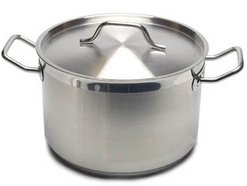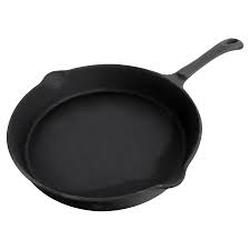- 1 8-9" Non-Stick Skillet
- 1 12" Sauté Pan with Lid
- 1 2-3 Quart Saucepan
- 1 5qt Covered Pot
- 1 10 inch Cast Iron Skillet
These five pieces of hardware will get you through 90% of the dishes you would want to tackle as a new entrant into the kitchen. Let's break down the pieces, explore them more in depth, talk about where to buy them, and answer a key question about each: non-stick or no?
This will be one of the main workhorses of your kitchen. Whether it be scrambling eggs, searing chicken, sautéing veggies, making grilled cheeses, or more, this medium sized pan will get the job done. Big enough for yourself and even if you're cooking for a guest, the 8-9" skillet will be a staple.
Look for a skillet with curved sides and is about 1.5" deep. An oven proof handle will make the pan even more versatile as would one with a heat proof, rubbery coating for extra grip. Check the labels to make sure it can handle at least 350 degrees in the oven. Finally, make sure the pan feels balanced and comfortable to hold. Pretend you are carrying it from the stove to the counter. Is it too heavy? Does it feel cheap? Play with it.
Sometimes you need to cook for more than one or two people. This is what the 12" sauté pan is for. Apart from the larger size, this larger pan can help serve double duty as a roasting pan in a pinch. This is why this pan being non-stick is a "maybe". While non-stick coatings are convenient, non coated pans can more readily pop into the oven and also work better if you want to make a pan sauce, something I will cover in a future post. Same rules from the 8-9" skillet applies. Test for comfort and balance. If you go for an uncoated pan, make sure the handle is also solid metal, no rubber or plastic please. The lid should be fit tighly with no gaps and well fitted.
Another workhorse of the new chef's kitchen, this pot will do it all - make rice, pasta, cook veggies, and more. You want a saucepan to be slightly wider than it is tall and has a tight fitting lid. You may have noticed I said that non-stick is ok here. Some more experienced chefs may take issue with this, but from my experience, making rice, sauces, and things beyond soup in a non-stick pot is just too convenient to pass up. Given how busy you already are, cleaning time and effort needs to be strategically rationed.
Sometimes you need a big pot. This is for those big dinner nights where you are making pasta for your group of friends or a large batch of soup for a cold, snowy day. You want this pan to be stainless steel and not non-stick. Given that I have yet to come across a pot this large with non-stick coating, I think no coating is the standard. Look for a pot with a tight fitting lid and two loop handles that can be easily handled with oven mitts, (imagine trying to grab the loops if your hands were suddenly twice as big).
Your grandmother probably had one of these. Actually, she may still have it and use it to this day. A well cared for cast iron skillet can and will last practically for a lifetime and then some. The beauty of cast iron lies in its weight which allows it to absorb a lot of heat and get and stay hot vey evenly. Want to make a steak, cook veggies, or make the best fajitas ever all in one pan? Get a cast iron skillet. Fry chicken or make cornbread? Get a cast iron skillet. Non-stick cast iron does not really exist and I would not recommend it; the beautiful color and unique taste from cooking in cast iron make it worth the extra care it requires.
Shopping:
Now you might be wondering where to buy these items. Yes, there is the magic of the internet, but part of shopping for kitchen hardware is being able to handle and feel the pots and pans before buying them. Remember, these tools will be things you will be working with on regular basis. Like shopping for business wear, it's worth spending a little extra to get higher quality, more comfortable, and durable product that will last longer and produce better food.
When shopping for all of the above, there are some characteristics I look for. Weight and heft is desirable. Cheap pans are light because they are made from thin gauge metals and thus don't heat as evenly and are more easily damaged. You don't want to feel like you would want to do curls with your pans (cast iron skillet aside), but a little weight will help you cook much better.
Handles are also an important part to look at. Metal handles are preferable if you want pans that can easily jump between the stovetop and oven, but heat resistant rubberized handles are easy to work with. No matter which direction you choose, avoid plastic handles and loose handles. Hold the main body of the pan and try and wiggle the handle. Does it move? Even a little? Good pans will have handles joined to the body using only metal and with firm fasteners that will not move.
For many of these items, I would recommend discount chains such as Homegoods, Marshalls, and TJ Maxx as they often have high quality brands and products at a reasonable price. As long as you don't mind pieces not necessary matching perfectly or coming from the same brand, these will let you get what you need without breaking the bank. The only caveat is the cast iron pan. From what I have noticed, cast iron is most easily found at kitchen specialty stores or take the route I did and order one off Amazon. I personally am a fan of Lodge cast iron.
The final question you may have is whether or not you should go with packaged sets of cookware. There is no firm answer for this. Many sets come with extra pieces and pans which might not be useful or lack the right combination of features that buying pieces a la carte allows you to control. Many sets come either all non-stick or all uncoated for example. You want to be able to handle and feel all the pieces you buy first as well and packages make that more difficult. Some packages may be appealing because they are cheaper, but to reach all the right necessary pieces you need in the right combination of features can easily remove that savings once the rest of the pieces are purchased separately. My suggestion? Go a la carte.
With these five pieces of hardware, you now have the first set of tools to outfit your kitchen. But even with these five pieces, it wouldn't be complete without some supporting players. Stay tuned for Gear Part II: Knives, Knives, Baby.






